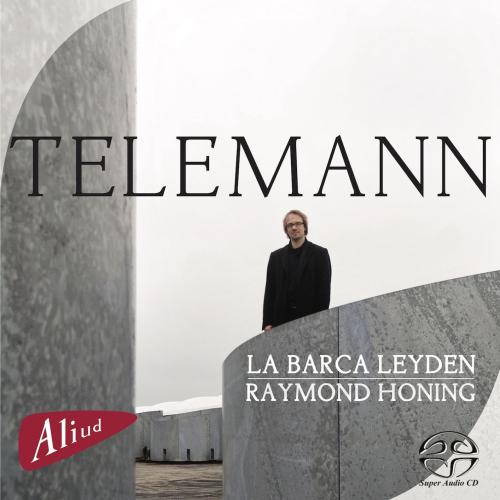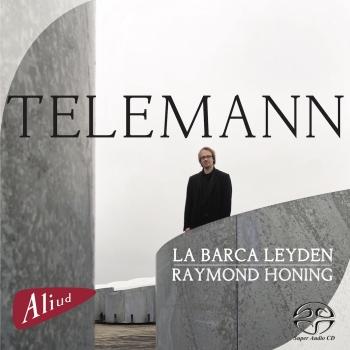
Telemann (Remastered) La Barca Leyden & Raymond Honing
Album info
Album-Release:
2011
HRA-Release:
24.05.2017
Label: Aluid Records
Genre: Classical
Subgenre: Chamber Music
Artist: La Barca Leyden & Raymond Honing
Composer: Georg Philipp Telemann (1681-1767)
Album including Album cover Booklet (PDF)
- Georg Philipp Telemann (1681 - 1767):
- 1 Trio Sonatas - Soave 01:54
- 2 Trio Sonatas - Presto 01:40
- 3 Trio Sonatas - Andante 02:04
- 4 Trio Sonatas - Scherzando 01:38
- 5 Fantasie no. 2 in a minor - Grave Vivace, Adagio. Allegro 05:13
- 6 Fantasie no. 7 in D major - Alla Francese, Lasgo, Presto 04:24
- 7 Suite in G - Prelude 01:59
- 8 Suite in G - Air 03:03
- 9 Suite in G - Air Dolce 03:15
- 10 Suite in G - Air Allegro 01:32
- 11 Suite in G - Spirituoso 02:47
- 12 Suite in G - Piacevole 03:11
- 13 Suite in G - Allegro 02:37
- 14 Fantasie no. 8 in e minor - Largo, Spirituoso, Allegro 04:12
- 15 Fantasie no. 11 in G Major - Allegro + Adagio, Vivace, Allegro 04:10
- 16 Cantata 5. Ein Jammerton - Largo 05:59
- 17 Cantata 5 - Recitatievo, Jedoch mein Blick 01:02
- 18 Cantata 5 - Aria, In deiner Gnaden offne Tiefe 04:16
Info for Telemann (Remastered)
This selection of chamber works attempts to give an impression of the originality and inventive craftsmanship of Telemann. La Barca Leyden achieve this through admirable playing and a love of early baroque music. Formed in 2007 by flutist Raymond Honing, the ensemble specialize in historical performances, actively promoting music from this period.
Telemann, an enterprising innovator: Georg Philipp Telemann (1681-1767), if his mother had had her way, would never have become a composer. Despite the fact that he composed large-scale works from a very early age, his mother insisted that he should study law in Leipzig. But it was soon evident that his heart lay in music. Passing through Halle on his way to Leipzig, he took the opportunity to make acquaintance with George Frideric Handel, with whom he established a friendship. Telemann showed perseverance (a trait which was to stand him in good stead), and stuck to his ambitions as a composer. He gained a post in Leipzig, where he founded the Collegium Musicum later directed by Johann Sebastian Bach. Posts in Sorau, Eisenach (where he got to know Bach) and Frankfurt followed, and in 1721 he gained a top position as music director of nearly all the major churches of Hamburg. A year later he succeeded Reinhard Kaiser as artistic director of the Hamburg Opera. Until his death in 1767, Telemann lived and worked in Hamburg, and it would not be exaggerating to say that he was the most famous and popular composer of his day in Germany. This is partly due to the quality and scale of his oeuvre, and partly to the fact that he was a born entrepreneur, conscious of his talent and quite capable of using all modern means to bring his music to the attention of the public. Unlike many of his colleagues, Telemann was actively involved in the publication of his own works. He also founded Der Getreue Musikmeister, a sort of musical magazine in which new pieces by himself and others were published, thus finding their way into circles of domestic music making.
Telemann had good reason for his self-confidence, as appeared when he made moves to become involved in the Hamburg opera. His church employers hardly shared his enthusiasm, and requested him to abandon his plans. Telemann threatened to resign, and applied for the post of cantor at the Thomaskirche in Leipzig. He was accepted there, but his Hamburg employer wished to keep him and was obliged to raise his salary and withdraw his objections to things operatic. And so Telemann
did not turn up in Leipzig, and the church authorities there had to make do with their second choice: Johann Sebastian Bach.....
During his lifetime, Georg Philip Telemann was nothing less than a star. In our day, however, he has often been viewed primarily as a prolific writer. This is unjust, although it can hardly be denied that he wrote a lot of music - it is indeed the question whether there has ever been a composer with more pieces to his name. But the term prolific has had a negative effect on Telemann's reputation, and this is directly related to our changing attitude through the centuries to the creative arts. Since the Romantic era, it has become increasingly important for a composer to create a unique, distinguishing oeuvre. In the eighteenth century, composing was much more a craft - unavoidably so in view of the amount of music that was needed. The modern listener may enjoy hearing works from times past, but in the Baroque this was a different matter. Looking back into the past was less of a habit, and modern music was a significant aspect of cultural and social life. On the ease with which Telemann could produce works of high quality, George Frideric Handel said "he writes an eight-part piece just as easily as anybody else writes a letter".
Part of Telemann's oeuvre is without doubt background music of the very best sort, while another part is full of exceptional compositions, many of which are characterized by remarkably original use of harmony, rhythm and instrumentation. Through this modern style, Telemann played a prominent role in music history, paving the way, for instance, for the innovations of Joseph Haydn. Being solo pieces, the 12 Fantasias, together with the solo sonatas by J.S. Bach and C.Ph. E. Bach, occupy a unique place in the Baroque repertoire of flute players. Telemann employs 12 different keys and exploits the characteristic colours and moods of each one of them. One could even make a modest comparison with the 24 keys employed by J.S. Bach in his Wohltemperierte Klavier. In the four fantasias that I have selected, Telemann makes full use of his creative imagination.
The opening movement of the Fantasia in D major is in the French style, imitating, as it were, an orchestral overture by Lully. One moment he is clearly inspired by the Polish folk music of which he was so fond, while the next, as in the opening of the G-major Fantasia, we hear the fragility of the opening of Bach's first cello suite. But perhaps the greatest merit of this series of fantasias lies in Telemann's ability to conjure up a whole universe by means of a few simple notes, as in the first bars of the A-minor Fantasia.
Although the fantasias are highly popular among flute players, this is hardly true of the rarely played Suite in G major. This large-scale work for traverso and harpsichord is a fine example of one of the main features of Telemann's style, combining as it does the national styles that dominated the music world of his day. Italian and French traits alternate, with the occasional touch of Polish folk music.
The cantata Ein Jammerton, ein schluchzend ach comes from the volume of solo cantatas Harmonischer Gottesdienst (1725). The key of C minor lends the work a conspicuously dark mood. In the first movement in particular, Telemann makes subtle use of the timbres of the violin and traverso, as they comment on or accompany the solo voice. In the last movement of the Trio Sonata in E major from the Essercizii Musici, finally, the influence of folk music is once more evident.
This selection of chamber music attempts to give an impression of the inventivity, originality and craftsmanship of Telemann. Not without reason, the composer and music theorist Mattheson wrote the words:
"Lully is celebrated, Corelli enjoys fame, Telemann alone is above all praise."
He didn't just say that about anybody.
Raymond Honing, flute
La Barca Leyden
No biography found.
Booklet for Telemann (Remastered)










